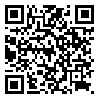BibTeX | RIS | EndNote | Medlars | ProCite | Reference Manager | RefWorks
Send citation to:
URL: http://jdisabilstud.org/article-1-2609-en.html

 , Mohammad Reza Seirafi *2
, Mohammad Reza Seirafi *2 
 , Adis Keraskian Moojembari2
, Adis Keraskian Moojembari2 
 , Ahmad Borjali3
, Ahmad Borjali3 
 , Tahereh Ranjbaripoor2
, Tahereh Ranjbaripoor2 

2- Assistant Professor, Department of Psychology, Karaj Branch, Islamic Azad University, Karaj, Iran
3- Professor, Department of Clinical Psychology, Faculty of Psychology and Educational Sciences, Allameh Tabataba'i University, Tehran, Iran
Abstract
Background & Objectives: Adolescence is a period of human development in which profound changes occur in a person's physical and psychological structure. Professionals have stated that because mental health problems, as well as personality and behavioral patterns of individuals, are difficult to change in adulthood, timely measures to diagnose mental health problems in children and adolescents are one of the main concerns of the mental health system. Obsessive–compulsive disorder is a neurological disorder that affects up to 1% of children and adolescents. Early maladaptive schemas are the deepest cognitive–emotional components that cause obsessions. In schema therapy, which is a modified and integrated form of cognitive therapy, it is assumed that experiences based on neglect and or abuse in childhood can lead to the formation of early maladaptive schemas. So, this study aimed to evaluate the effectiveness of individual schema therapy on obsessive–compulsive symptoms in adolescent girls.
Methods: The method of the present study was quasi–experimental with a pretest–posttest and two months follow–up design with a control group. The study’s statistical population was all female ninth–grade of junior high school students in Ghods City, Iran, in the 2019–2020 academic year. Of whom 30 students were selected by the available sampling method. Then, they were randomly assigned to two groups: individual schema therapy and control. The inclusion criteria were as follows: living together with both parents, the absence of a probationary semester in the student's record, lacking disabilities, chronic physical illnesses and severe mental illnesses, and not receiving psychotherapy or medication during the past year. The exclusion criterion was the refusal of cooperation. The study subjects answered Maudsley Obsessive–Compulsive Inventory (Hodgson & Rachman, 1977) at the pretest, posttest, and follow–up. Young et al. Schema therapy (2006) was conducted in 12 individual 90–min sessions for the experimental group. To describe the obtained data, descriptive statistics (mean, standard deviation, frequency, and percentage) were used. For data analysis, the Chi–square test, analysis of variance with repeated measurements, and Bonferroni post hoc test were used in SPSS version 24 software. The significance level of statistical tests was considered 0.05.
Results: The individual schema therapy for the experimental group reduced obsessive–compulsive symptoms compared to the control group (p=0.025). Also, the mean score of obsessive–compulsive symptoms during the study time showed a significant difference between the experimental and control groups (p<0.001). In the experimental group, a significant difference was observed between the mean scores of the pretest and posttest (p=0.002) and the pretest and follow–up (p=0.001) regarding the variable of obsessive–compulsive symptoms, and the non–significance of the averages in the posttest and follow–up stages shows the persistence of this effect in the follow–up (p=0.074).
Conclusion: According to the findings, individual schema therapy effectively and efficiently reduces adolescent obsessive–compulsive symptoms. Therefore, it is suggested to use individual schema therapy to reduce obsessive–compulsive symptoms of teenage girls, especially in schools.
| Rights and permissions | |
 |
This work is licensed under a Creative Commons Attribution-NonCommercial 4.0 International License. |

